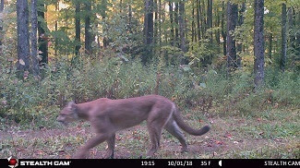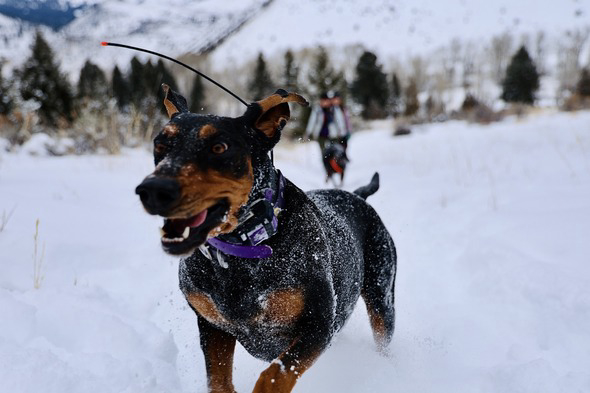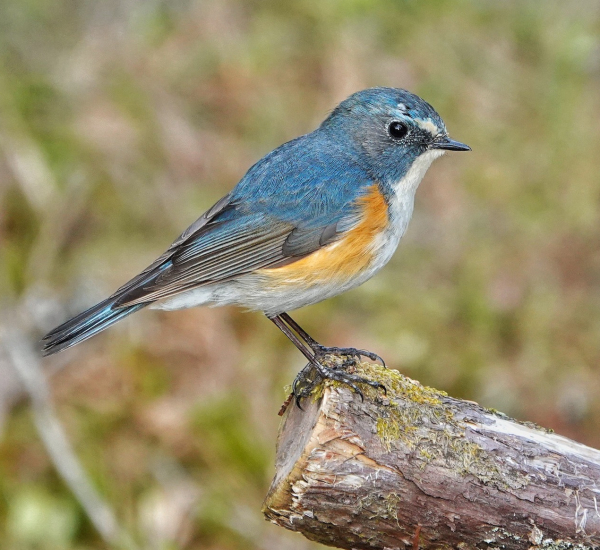Michigan Mountain Lion Sighted
By Glen Wunderlich
In the past 10 years, the Michigan DNR has confirmed a total of 38 reports of mountain lions with all but one occurring in the Upper Peninsula – the last one being October 1st of this month.

Cougar caught on DNR trail camera October 1, 2018
Since multiple sightings of the same animal have been verified, the total number of the massive cats may well be much less, but who really knows?
The last image was found on a game camera installed by the DNR to study deer movement 9 miles north of Ironwood in Gogebic County. “This latest confirmed report illustrates just how rare cougars are in the Upper Peninsula,” said Brian Roell, a DNR wildlife biologist in Marquette. “This is the first time we’ve ever caught a cougar on more than three million game camera images we’ve collected in our studies since 2009.”
They may be rare indeed, but nonetheless, knowing that these wild, carnivorous cats weighing as much as 200 pounds or more roam the wilderness in the land of Yoopers is a bit scary for this outdoorsman. Oh, I can hear the odds makers on the chances of such an encounter, but I’d rather bet on my chances with a .44 magnum than playing dead – which by the way is a good way to end not only the game, but one’s life.
Human contact is still rare, but one account earlier this year in Washington State went against the odds. A mountain lion, or cougar if you will, killed one mountain biker and mauled another in May, when they rode into its territory; authorities later shot the animal dead.
Family pets have also become prey, as was the case February 9, 2017 in Glendale, California. Erinn Brown said everything seemed normal when she opened a door and let out her poodle outside. “Then I saw that our dog was hanging limp from the top of the fence,” she said. The mountain lion then jumped over the fence and departed.
According to the DNR, there remains no conclusive evidence of a Michigan breeding population of mountain lions.
Previous genetic testing on tissue samples from two cougars poached in the U.P. showed the two animals likely came from a population found generally in South Dakota, Wyoming and northwest Nebraska.
“This genetic research lines up with what we’ve presumed previously, that cougars found in the Upper Peninsula are males dispersing from this population east of the Rocky Mountains,” said Kevin Swanson, a DNR wildlife management specialist with the department’s Bear and Wolf Program. “These males dispersed from the main population are looking to establish new territories.”
Researchers investigated the potential population of origin for the two cougars using a database that includes samples from cougar populations in South Dakota, North Dakota, Nebraska, Montana, Wyoming, Colorado, New Mexico, Arizona, Texas, Oregon and Florida. Cougars are an endangered species in Michigan protected by law.
At one time, cougars lived in every eastern state in a variety of habitats including coastal marshes, mountains and forests. They were native to Michigan, but were trapped and hunted from the state over 100 years ago.
Thirteen western states allow cougar hunting and the North American cougar is listed there as a game species.
J.R. Abser reports that one student-led project was directed by the University of Washington’s Laura Prugh and initiated as part of a community ecology class she taught in 2014 at the University of Alaska Fairbanks. “The important take-home is that there can be very tangible benefits to having large carnivores around — economic and social benefits, not just ecological benefits,” said Prugh, a UW assistant professor of quantitative wildlife sciences in the School of Environmental and Forest Sciences.
The conclusion showed value in reducing deer-vehicle collisions as a case study, that within 30 years of the big cats recolonizing the Eastern U.S., the species could thin deer populations and reduce vehicle collisions by 22 percent — each year preventing five human fatalities, 680 injuries and avoiding costs of $50 million.
Could this be the answer to controlling our vehicle/deer collisions and Chronic Wasting Disease? I sure hope not!







